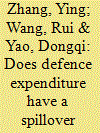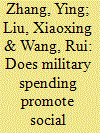|
|
|
Sort Order |
|
|
|
Items / Page
|
|
|
|
|
|
|
| Srl | Item |
| 1 |
ID:
155845


|
|
|
|
|
| Summary/Abstract |
China’s defence expenditure has been growing rapidly along with GDP growth during the past two decades. Meanwhile, the income gap has continued to increase. There are conflicting views regarding whether the defence expenditure is capable of reducing income inequality. Therefore, this paper investigates the existence of any spillover effect of defence expenditure on income inequality, with a special focus on the regional differences among 31 provinces and 7 military regions in China. We extend panel cointegration and the impulse response function by using panel data during the period of 1997–2012. The empirical results show that the defence expenditure has an impact on income inequality, and the effect varies over different regions in China. The defence expenditure has a spillover effect on income inequality in the full sample panel and the southeastern panel. An increase in the defence expenditure does not crowd out social welfare spending due to the high level of economic development and government expenditure. On the contrary, in the northern panel, the effect is opposite because of the unbalanced economic development levels within the panel. Beijing as the capital of China, benefits more from the expansion of defence expenditure thus widening the income gap. In addition, the impulse response analyses further confirm a stronger effect of the defence expenditure on income inequality in the northern and the southeastern panels over a short period.
|
|
|
|
|
|
|
|
|
|
|
|
|
|
|
|
| 2 |
ID:
155841


|
|
|
|
|
| Summary/Abstract |
Whether military spending is capable of promoting social welfare is currently a controversial issue. The aim of this paper is to investigate how military spending affects the input and output of social welfare (i.e. social welfare expenditures and social welfare index). A panel cointegration analysis and an impulse response function are conducted with multi-country panel data, over two time periods, 1998–2011 and 1993–2007. In addition, to extend a comparative analysis over different economies, BRICS (i.e. Brazil, Russia, India, China, South Africa) and G7 (i.e. the US, Japan, Germany, the UK, France, Italy, Canada) countries are selected as representatives of emerging economies and developed countries, respectively. The empirical results show that military spending enhances social welfare expenditures in developed countries, while the effect is ambiguous in emerging economies. Also, military spending is capable of promoting the social welfare index based on the FMOLS estimation. The comparative analyses indicate that unlike in the G7, the effect of the growth of military spending on the growth of social welfare expenditures is negative and shorter in the BRICS.
|
|
|
|
|
|
|
|
|
|
|
|
|
|
|
|
| 3 |
ID:
110757


|
|
|
|
|
| Publication |
2011.
|
| Summary/Abstract |
This study analyzes the effects of oil price fluctuations on regional macroeconomic variables with a structural VAR model. We classified fifteen metropolitan cities and provinces of Korea into four major regions (Capital, Central, Honam, and Gyeongsang) and examined the effects of oil price fluctuations on the economy of these regions. The results in the short- and long-term lag structures show a negative response to industrial production and price. The Capital region is less affected by oil price fluctuations than the other three provincial regions. We concluded that the government should focus on creating an industrial environment to accumulate production factors and technologies in oil price-sensitive regions.
|
|
|
|
|
|
|
|
|
|
|
|
|
|
|
|
|
|
|
|
|